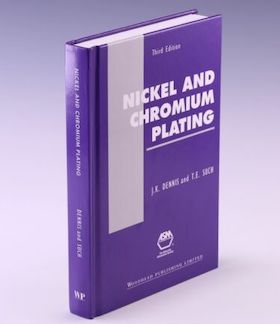
Curated with aloha by
Ted Mooney, P.E. RET

The authoritative public forum
for Metal Finishing 1989-2025

-----
Chrome plating has poor coverage
Q. Some times when I put chrome over a bright nickel I only get chrome on the high density areas. The part seems to be plating in pulses -- it bubbles, then stops, then starts again. This usually happens when I reach the maximum size part I can do. Could this be a power shortage problem or an anode problem? I use lead plates for my anodes. Thanks.
William Steeverplating - Fredericton, N.B., Canada
2005
A. Hi William. Chrome plating is less than 20 percent efficient, which in turn means there is just no possibility of chrome plating occurring when there is no hydrogen gassing. So the problem is indeed on the electrical side. What color are the anodes in the vicinity of the areas that aren't plating? It could be anodes that aren't making good contact, but it sounds more like a rectifier problem ... probably broken but maybe just not big enough.

Ted Mooney, P.E.
Striving to live Aloha
finishing.com - Pine Beach, New Jersey
2005
A. The last time I got that problem, it was an unknown rectifier defect that reduced the capacity; it wasn't enough big or capable with big pieces.
We changed it and the problem was gone.
- BUCARAMANGA, SANTANDER, COLOMBIA
2005
|
|
A. William,  Anders Sundman 4th Generation Surface Engineering Consultant - Arvika, Sweden 2005 A. Check your connections at the anode and the rack to the bar and to the parts. Dirty connections prevent current flow, especially when they get hot. James Watts- Navarre, Florida 2005 A. William - Ajman, UAE 2005 |
Q. We are doing tri-layer nickel-chrome decorative plating and are depositing like 0.5 micron of chrome. Recently I had been observing lack of coverage in particular component. I was thinking it could be a problem with that particular component's jig. But some other components are also found with same issue (no coverage in chrome). Kindly help me with this. Can you tell what are the factors I should check (and about jigs too). Thank you.
gibson A- Chennai, Tamilnadu, India
October 19, 2012
A. Hi Gibson. I think the first thing to do is a Hull Cell test, so you know whether the problem is the plating solution itself, or the electromechanical areas like the rectifier, anodes, and jigging. Good luck.
Regards,

Ted Mooney, P.E.
Striving to live Aloha
finishing.com - Pine Beach, New Jersey
October 22, 2012
Q, A, or Comment on THIS thread -or- Start a NEW Thread
